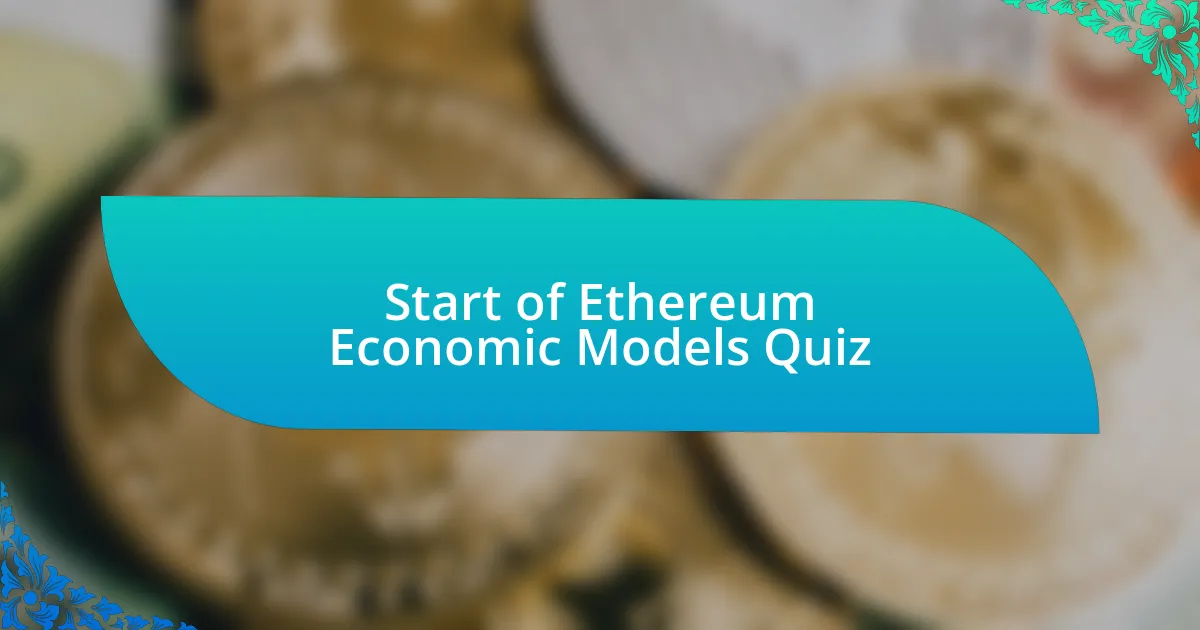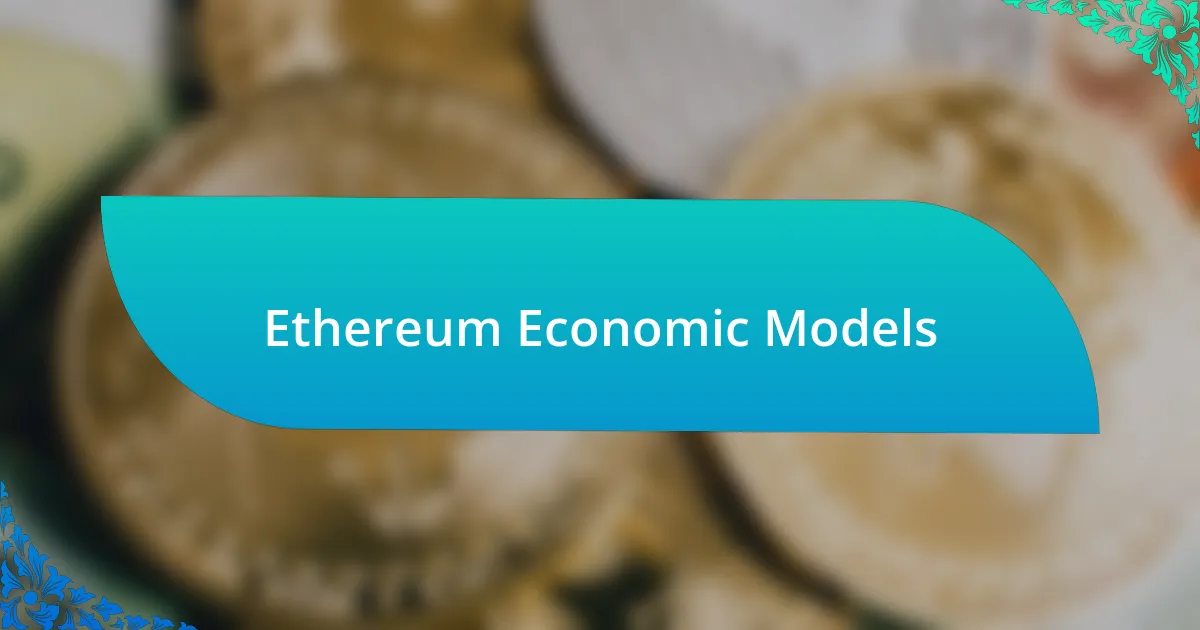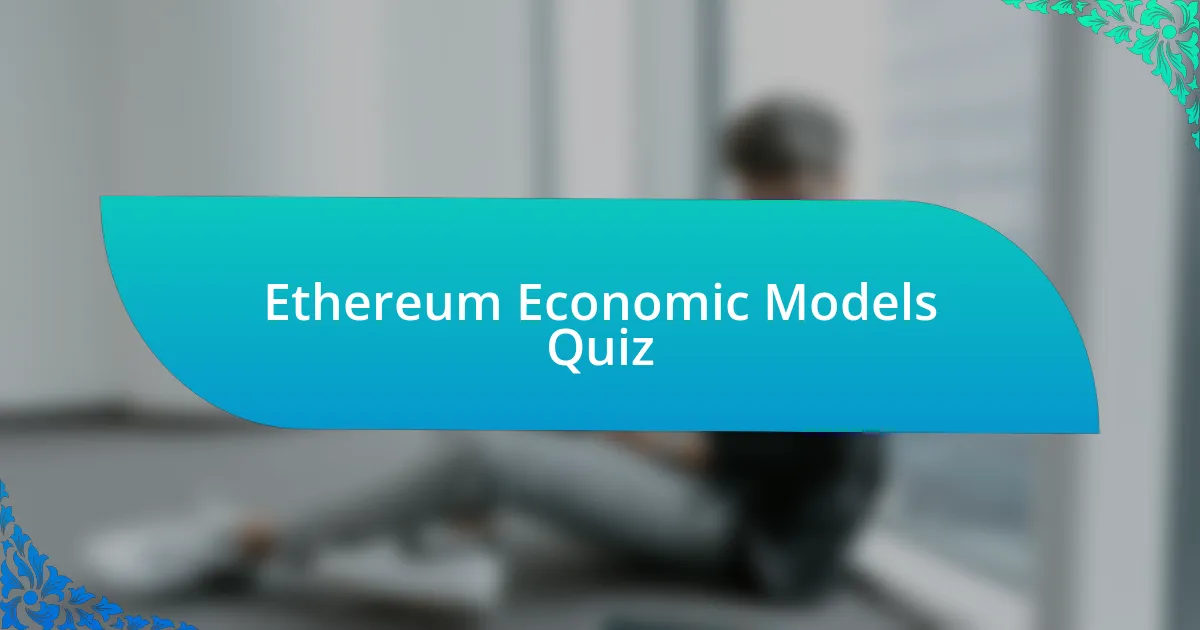
Start of Ethereum Economic Models Quiz
1. What transition in Ethereum`s economic model significantly impacts energy consumption?
- Proof-of-Stake
- Byzantine Fault Tolerance
- Delegated Proof-of-Stake
- Proof-of-Work
2. What function does gas serve in Ethereum`s economic model?
- Gas functions as a storage solution for transaction data on the blockchain.
- Gas is a cryptocurrency that is used to purchase tokens.
- Gas is used to measure the computational effort required to execute transactions and smart contracts, and it is priced in Ether (ETH).
- Gas enables the creation of new cryptocurrencies within the Ethereum network.
3. How does a high gas price influence the speed of transaction inclusion in Ethereum?
- A high gas price increases the likelihood of a transaction being included in a block.
- A high gas price decreases the transaction fees paid by users.
- A high gas price guarantees faster processing of all transactions.
- A high gas price has no effect on transaction inclusion in blocks.
4. What defines the maximum gas usage for transactions in Ethereum`s blockchain?
- Block gas limit
- Transaction limit
- Gas price cap
- Mining difficulty
5. What rewards do miners receive for their activities in the Ethereum network?
- Miners receive interest from staking.
- Miners receive dividends from network profits.
- Miners receive payment in Bitcoin.
- Miners receive block rewards and transaction fees.
6. What happens to any gas that is not utilized during transaction execution?
- Unused gas is distributed among miners.
- Unused gas is donated to the network.
- Unused gas is returned to the transaction sender.
- Unused gas is lost permanently.
7. Who determines the order of transactions in Ethereum?
- Miners
- Oracles
- Users
- Developers
8. What effect does high gas pricing have on transaction prioritization?
- A high gas price increases the likelihood of a transaction being included in a block.
- A high gas price decreases transaction fees.
- A high gas price reduces miner incentives.
- A high gas price has no effect on transaction prioritization.
9. In what way does the gas system protect Ethereum against DoS attacks?
- The gas mechanism prevents DoS attacks by limiting the computational effort required to execute transactions, thus preventing malicious behavior.
- The gas mechanism allows for unlimited transactions, making the network immune to DoS attacks.
- The gas mechanism guarantees that all transactions are processed at no cost, preventing DoS attacks.
- The gas mechanism increases the processing speed of transactions, eliminating the risk of DoS attacks.
10. How is gas evaluated within the Ethereum Virtual Machine?
- Gas is determined by the size of the transaction only.
- Gas is irrelevant to the execution of smart contracts.
- Gas is a fixed fee for all transactions on Ethereum.
- Gas is used by the EVM to measure the computational effort required to execute EVM opcodes.
11. What process manages the execution of smart contracts within Ethereum?
- Smart Contract Management System
- Blockchain Consensus Algorithm
- Crypto Execution Framework
- Ethereum Virtual Machine (EVM)
12. Who is responsible for validating transactions in Ethereum’s PoS model?
- Miners
- Users
- Nodes
- Validators
13. What change occurs to Ethereum`s economic model with its shift to PoS?
- It increases gas prices.
- It reduces energy consumption.
- It eliminates transaction fees.
- It requires more miners.
14. How does network congestion affect processing efficiencies within Ethereum?
- High network congestion decreases transaction fees significantly.
- High network congestion can lead to slower processing times and increased fees.
- High network congestion speeds up transaction processing times.
- High network congestion has no effect on transaction speeds.
15. What occurs when a transaction runs out of gas during execution?
- Transactions are reverted, and used gas is credited to the miner.
- Transactions are automatically canceled and refunded in full.
- Transactions succeed without any penalty.
- Transactions continue without any impact on the gas used.
16. What connection exists between gas and the overall transaction capacity in a block?
- The block gas limit influences transaction capacity in a block.
- Gas has no effect on transaction processing times.
- The gas price determines block size, not transaction capacity.
- Gas is unrelated to transaction fees in Ethereum.
17. How do smart contracts leverage the gas structure in Ethereum?
- Smart contracts leverage gas to physically transport transactions across the network.
- Smart contracts use gas for securing user identities on the network.
- Smart contracts leverage gas by using it as a storage medium for data.
- Smart contracts use gas to pay for computational resources needed for execution.
18. In what scenario might low gas fees be beneficial for users?
- During periods of low network congestion.
- While sending emails.
- When trading on stock exchanges.
- For online gaming tournaments.
19. How does Ethereum organize operations that can lead to infinite loops in smart contracts?
- The gas mechanism limits execution time through gas limits.
- Smart contracts are automatically terminated after a time limit.
- Infinite loops are detected and blocked by miners.
- Ethereum uses a built-in timer to track execution.
20. How do external data providers relate to Ethereum`s smart contract security?
- Oracles decrease the cost of transactions in Ethereum.
- Oracles provide external data to smart contracts, enhancing security.
- Oracles solely increase gas limits for transactions.
- Oracles regulate the order of transactions in blocks.
21. What is a consequence of Ethereum’s shift to PoS on computational resource needs?
- It has no effect on computational resources.
- It reduces the need for computational resources.
- It makes computational resources more expensive.
- It increases the demand for computational resources.
22. What connection does increased gas pricing have with network traffic?
- Higher gas pricing can lead to increased demand for transactions.
- Gas prices have no impact on network traffic.
- Higher gas prices decrease transaction speeds significantly.
- Increased gas prices encourage less use of the network.
23. How do unused portions of gas influence transaction outcomes?
- Unused gas increases the transaction fees for future transactions.
- Unused gas is distributed to miners as a bonus.
- Unused gas is returned to the transaction sender.
- Unused gas is burned to reduce network congestion.
24. In what way does the gas limit affect Ethereum’s scaling abilities?
- The gas limit impacts the total supply of Ether.
- Gas prices determine the speed of network transactions.
- The block gas limit restricts computational execution per block.
- Gas fees allow for unlimited transaction processing capabilities.
25. How is the integrity of smart contracts ensured in the Ethereum economic model?
- Ethereum`s blockchain provides unlimited resources.
- Gas limits execution time and resource use.
- Smart contracts run endlessly without checks.
- Integrity is ensured through centralized validators.
26. What results from a sudden change in block gas limits on transaction dynamics?
- All transactions are free.
- Transaction speeds may vary.
- Smart contracts stop functioning.
- Prices of Ether will drop.
27. What effect does PoS have on power distribution in the Ethereum ecosystem?
- PoS leads to unlimited energy consumption without restrictions.
- PoS has no impact on power distribution within the ecosystem.
- PoS increases centralization of power in mining groups.
- PoS improves power distribution and reduces energy consumption.
28. How does the function of oracles enhance the reliability of smart contracts?
- Oracles provide external data to smart contracts, enabling them to make decisions based on real-world information.
- Oracles are responsible for creating new blocks in the blockchain.
- Oracles maintain the gas price for transactions within the network.
- Oracles establish consensus among miners to validate transactions efficiently.
29. What implications arise when transactions exceed a specified block gas limit?
- Transactions are queued until the next block is mined.
- Transactions are executed but with reduced gas fees.
- Transactions are automatically prioritized and processed.
- Transactions are not included in the block and are reverted.
30. How do gas prices correlate with transaction cost structures in Ethereum?
- Gas prices have no effect on transaction fees in Ethereum`s structure.
- Gas prices only impact miner revenue, not transaction costs directly.
- Gas prices directly influence transaction fee structures based on network demand.
- Gas prices are determined solely by the Ethereum block size limit.

Quiz Successfully Completed!
Congratulations on completing the quiz on Ethereum Economic Models! We hope you found it both enjoyable and enlightening. Throughout the questions, you’ve likely discovered key principles that govern Ethereum’s unique economic structure. Understanding the factors of supply, demand, and incentives within this ecosystem is crucial for anyone interested in blockchain technology.
As you navigated through the quiz, you may have learned about the impact of Ethereum’s transition from proof-of-work to proof-of-stake. This shift is significant, affecting everything from energy consumption to network security. It is essential to grasp how these economic models influence not just Ethereum but the broader cryptocurrency market.
Feel free to explore the next section on this page, where we dive deeper into Ethereum Economic Models. This material will enhance your understanding and provide you with a richer perspective on these concepts. Expanding your knowledge is the next step towards becoming proficient in the complexities of Ethereum and its economic implications.

Ethereum Economic Models
Overview of Ethereum Economic Models
Ethereum economic models describe the various mechanisms that govern its native cryptocurrency, Ether (ETH), and the overall economic ecosystem within the Ethereum network. These models influence factors like transaction fees, token supply, and network incentives. Ethereum’s economic structures aim to balance user participation, security, and sustainability. The shift to Ethereum 2.0 introduced proof-of-stake, altering the dynamics of rewards and validation. This transition reflects a broader trend towards energy efficiency and scaling within blockchain economics.
Supply Dynamics in Ethereum
The supply dynamics in Ethereum relate to how Ether is issued and managed over time. Initially, Ether had an uncapped supply, but the implementation of EIP-1559 introduced a fee-burning mechanism. This change means that a portion of transaction fees is permanently removed from circulation. Consequently, Ether can become deflationary, depending on network demand. The introduction of staking in Ethereum 2.0 further influences supply, as users lock up their assets to validate transactions, potentially reducing circulating Ether.
Transaction Fees and EIP-1559
Transaction fees on Ethereum are essential for incentivizing miners and validators. EIP-1559 restructured how these fees are calculated, introducing a base fee that adjusts based on network congestion. Users can add a priority fee for faster transactions. This dual fee structure aims to create more predictable costs for users while ensuring miners are compensated. The dynamic nature of these transaction fees plays a significant role in overall Ethereum economic stability.
Staking and Network Incentives
Staking on Ethereum 2.0 allows users to earn rewards by locking their ETH as collateral for validating transactions. This process promotes network security and decentralization. Validators receive rewards in the form of newly minted ETH and transaction fees. The staking model alters participant incentives, encouraging long-term holding and engagement with the network. This shift enhances user involvement and stability within Ethereum’s financial ecosystem.
Impact of Decentralized Finance (DeFi) on Ethereum Economics
Decentralized Finance (DeFi) significantly impacts Ethereum’s economic models. DeFi applications increase demand for transactions and smart contracts, driving up network usage. This heightened activity influences gas fees and liquidity. Additionally, many DeFi platforms use ETH as collateral, enhancing its utility. The growth of DeFi has led to new economic opportunities and challenges, including volatility and governance issues within the Ethereum ecosystem.
What are Ethereum Economic Models?
Ethereum economic models refer to the mechanisms and structures that govern the value and incentives within the Ethereum ecosystem. These models include transaction fees, miner rewards, and staking rewards. For instance, Ethereum 2.0 introduced a proof-of-stake mechanism that alters incentives for validators, moving away from the energy-intensive proof-of-work model. This shift aims to improve sustainability and scalability while impacting the overall supply and demand dynamics of Ether, Ethereum’s native currency.
How does Ethereum’s fee structure work?
Ethereum’s fee structure operates on a system known as “gas,” which measures computational work. Users pay gas fees to compensate miners or validators for processing transactions and executing smart contracts. Fees are dynamic and fluctuate based on network demand. In recent updates like EIP-1559, a base fee is burned, reducing Ether supply and creating deflationary pressure, establishing a more predictable fee mechanism.
Where can you find Ethereum economic data?
Ethereum economic data can be accessed through various blockchain analytics platforms, such as Etherscan, Glassnode, and Dune Analytics. These platforms provide real-time charts and statistics on transaction volume, gas prices, network fees, and the overall state of the Ethereum economy. They aggregate data from the blockchain, offering insights into economic activity, market trends, and user behavior.
When was the transition to Ethereum 2.0 announced?
The transition to Ethereum 2.0 was officially announced in late 2018, aiming to upgrade the Ethereum network from proof-of-work (PoW) to proof-of-stake (PoS). The rollout began with the Beacon Chain launch on December 1, 2020, marking the first phase of a multi-phase upgrade. This significant change is expected to be completed in subsequent phases, leading to enhanced scalability and sustainability.
Who benefits from Ethereum economic models?
Various stakeholders benefit from Ethereum economic models, including users, developers, and validators. Users gain access to decentralized applications (dApps) and services, while developers can monetize their projects through transaction fees or token sales. Validators, who participate in the proof-of-stake system, earn rewards for securing the network, creating a more robust economic incentive structure within the Ethereum ecosystem.

